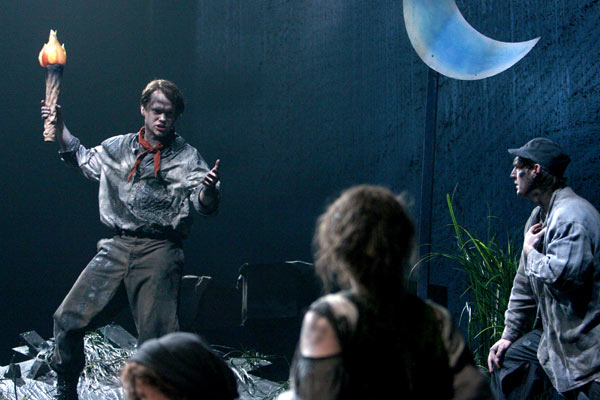
Stephen Louis Grush (left) in A True History of the Johnstown Flood, with Cliff Chamberlain as Richard
Continuity watch: Block those non-period pants fasteners!
THEATRE When you attend the theatre, little things can break the spell of the performance on stage. Maybe the person sitting next to you has an unsettling horse laugh. Or maybe some trivial detail of the performance causes your mind to wander. A few minutes into the second act of A True History of the Johnstown Flood—the ambitious but flawed new production by the Chicago playwright Rebecca Gilman now making its debut at the Goodman Theatre—a character suffering a bout of dysentery unzips his pants and climbs into a muddy hole to, um, take care of business.
Which got me wondering: Could people unzip their pants in 1889, the year of the Johnstown flood? I did a little post-play research (these articles at Wikipedia and About.com were helpful) and learned the truth: They couldn’t. A primitive version of the zipper—a "hook-and-eye" shoe fastener—was patented by a Chicagoan named Whitcomb Judson in 1893 (and exhibited that year at the World’s Columbian Exposition in Chicago). But that was four years after the Johnstown flood, and the "clasp locker," as that device was called, proved too unwieldy to be of commercial use anyway. Over the next two decades, improvements to the original design led to the development around 1913 of the modern zipper, with interlocking teeth pulled together or apart by an attached sliding tab. Despite the efficacy this "hookless fastener," clothing makers were not quick to see its advantages. Indeed, it wasn’t until two decades after the perfection of the zipper—in the 1930s—that a person would be likely to unzip his pants rather than unbutton them in answer to nature’s call.
And so, although A True History of the Johnstown Flood didn’t teach me much about the disaster I hadn’t already learned from watching The History Channel, it did motivate me to learn the true history of the humble zipper.
GO: Thru April 18. $25-$76. 170 N Dearborn, 312-443-3800. goodmantheatre.org
WHAT CRITICS THOUGHT OF A TRUE HISTORY OF THE JOHNSTOWN FLOOD
- The Chicago Tribune review by Chris Jones, 3/22:
"When your play promises the ‘true history’ of a flood, the audience is inevitably waiting for the water, even if the playwright wants to ponder social realism. We read the title; everything else feels like foreplay. [TWO STARS OUT OF FOUR]"
- The Chicago Sun-Times review by Hedy Weiss, 3/23:
". . . designer Walt Spangler’s lavish sets for [playwright Rebecca] Gilman’s production—which has been directed by Robert Falls with all the elephantine excess he too often lavishes on sub-par scripts—are the only reason to see this play. . . NOT RECOMMENDED."
- The Variety review by Steven Oxman, 3/22:
"Gilman has certainly displayed plenty of talent for peeling away layers of character—the latent racism within a liberal academic dean in Spinning into Butter, how fear can completely alter perception and morality in stalking drama Boy Gets Girl. But here, the characters don’t change much. And as a work questioning the very purpose of the theater itself, this play just doesn’t dig very deeply."
- The Time Out Chicago review by Kris Vire:
"Gilman packs enough information into her first act to set up five plays; by the time the flood hits—done in blackout, in a long, intense sound cue by the terrific designer Richard Woodbury—we’re just happy something’s finally happening. [TWO STARS OUT OF FIVE]"
- The Chicago Theater Blog review by Catey Sullivan, 3/23:
"The Goodman itself becomes an unintended, unavoidable and meta-theatrical punchline when one character opines with righteous indignation that some people go to the theater just to see the elaborate sets. [ONE AND A HALF STARS OUT OF FOUR]"
- From the April 2010 issue, Chicago’s feature profile of the playwright Rebecca Gilman, by Christopher Piatt.
Photographs: Eric Y. Exit


